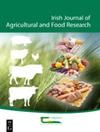The fatty acid profile and stable isotope ratios of C and N of muscle from cattle that grazed grass or grass/clover pastures before slaughter and their discriminatory potential
IF 1.4
4区 农林科学
Q3 AGRICULTURE, MULTIDISCIPLINARY
引用次数: 20
Abstract
Abstract Consumption of grazed pasture compared to concentrates results in higher concentrations, in beef muscle, of fatty acids considered to be beneficial to human health. Little information is available on the influence of the type of grazed forage. Our objectives were to determine 1) the effect of inclusion of white clover in a grazing sward on the fatty acid profile of beef muscle and 2) the potential of the fatty acid profile and stable isotope ratios of C and N to discriminate between beef from cattle that grazed grass-only or grass/clover swards before slaughter. A total of 28 spring-born Charolais steers grazed from March until slaughter in October, either on a perennial ryegrass (Lolium perenne L.) sward that received approximately 220 kg N/ha or a perennial ryegrass–white clover (Trifolium repens L.) sward that received 50 kg N/ha. The longissimus muscle from cattle finished on grass/clover had a higher (P < 0.05) proportion of C18:2 and C18:3 but a lower (P < 0.05) proportion of conjugated linoleic acid and δ15N value than animals finished on the grass-only sward. Discriminant analysis using the fatty acid data showed that, after cross-validation, 80.7% of grass/clover and 86.1% of grass-only muscle samples were correctly classified. Discriminant analysis using the stable isotope data showed that, after cross-validation, 95.7% of grass/clover and 86.5% of grass-only muscle samples were correctly classified. Inclusion of white clover in pasture is likely to have little effect on healthiness of meat for consumers. However, changes in fatty acids and stable isotopes can be used to distinguish between grass/clover-fed and grass-only-fed beef.宰前放牧或草/三叶草放牧牛肌肉脂肪酸分布、C、N稳定同位素比值及其鉴别潜力
摘要与浓缩物相比,食用放牧牧场会导致牛肉肌肉中被认为有益于人类健康的脂肪酸浓度更高。关于放牧草料类型的影响,几乎没有可用的信息。我们的目标是确定1)在放牧草地中加入白三叶草对牛肉肌肉脂肪酸谱的影响,以及2)脂肪酸谱和C和N的稳定同位素比率在区分牛肉和屠宰前只吃草的牛或草/三叶草草地的潜力。从3月到10月屠宰,共有28头春季出生的夏洛莱牛在多年生黑麦草(Lolium perenne L.)草地上放牧,每公顷收获约220公斤氮,或在多年生黑麦草-白三叶草(Trifolium repens L.)草地收获50公斤氮。草/三叶草处理的牛最长肌C18:2和C18:3的比例较高(P<0.05),但共轭亚油酸和δ15N的比例较低(P<0.05)。使用脂肪酸数据的判别分析表明,经过交叉验证,80.7%的草/三叶草和86.1%的纯草肌肉样本被正确分类。使用稳定同位素数据的判别分析表明,经过交叉验证,95.7%的草/三叶草和86.5%的纯草肌肉样本被正确分类。在牧场中种植白三叶草可能对消费者的肉类健康影响不大。然而,脂肪酸和稳定同位素的变化可以用来区分草/三叶草喂养和纯草喂养的牛肉。
本文章由计算机程序翻译,如有差异,请以英文原文为准。
求助全文
约1分钟内获得全文
求助全文
来源期刊
CiteScore
2.50
自引率
20.00%
发文量
23
审稿时长
>36 weeks
期刊介绍:
The Irish Journal of Agricultural and Food Research is a peer reviewed open access scientific journal published by Teagasc (Agriculture and Food Development Authority, Ireland). Manuscripts on any aspect of research of direct relevance to Irish agriculture and food production, including plant and animal sciences, food science, agri environmental science, soils, engineering, buildings, economics and sociology, will be considered for publication. The work must demonstrate novelty and relevance to the field of research. Papers published or offered for publication elsewhere will not be considered, but the publication of an abstract does not preclude the publication of the full paper in this journal.

 求助内容:
求助内容: 应助结果提醒方式:
应助结果提醒方式:


